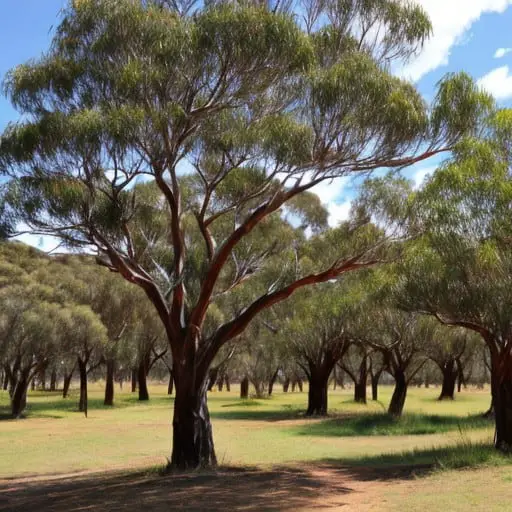Tea tree wood is derived from the Melaleuca alternifolia tree, also known as the tea tree or narrow-leaved paperbark. This tree is native to Australia and belongs to the Myrtaceae family.
Tea tree oil is well-known for its uses including skincare, oral health, aromatherapy and haircare. But did you know food smoking is another potential use for the wood itself?
Tea tree wood can be used for smoking various meats, fish and veggies. It offers a sweet but mild earthy flavor to robust and hearty meats such as beef or game but also for fish and vegetables like mushrooms and eggplant.
Benefits That Tea Tree Wood Offers For Food Smoking
Tea tree wood is known for its unique properties that make it a good choice for smoking foods. Here are some reasons why tea tree wood is considered good for smoking:
- Distinctive flavor: Tea tree wood offers a distinct and robust flavor to smoked foods. It imparts a slightly sweet and earthy taste, which can add depth and complexity to your dishes.
- Aromatic scent: Tea tree wood releases a pleasant and fragrant aroma while smoking. This aroma can enhance the overall sensory experience of your food, making it more enjoyable.
- High heat and long burn: Tea tree wood is known for its ability to generate high heat and provide a long burn. This makes it suitable for smoking foods at higher temperatures or for extended periods, ensuring thorough cooking and imparting a desirable smoky flavor.
- Natural and chemical-free: Tea tree wood is a natural and chemical-free option for smoking foods. It does not require any additional additives or flavorings, making it a healthier choice for those who prefer a more natural smoking process.
- Availability: Tea tree wood is relatively accessible in regions where tea tree plants are cultivated. It may be obtained as whole logs, wood chips, or chunks, depending on your smoking needs and equipment.
- Versatility: Tea tree wood can be used for smoking a variety of foods, including meats, poultry, fish, vegetables, and even cheese. It is a versatile wood that can complement different ingredients and recipes.
When using tea tree wood for smoking, it is important to ensure that it is properly seasoned and dried to achieve optimal results. Additionally, be mindful of the intensity of the smoke, as tea tree wood can have a strong flavor profile. Adjusting the amount and duration of smoking will help you achieve the desired taste for your dishes.
Foods That Smoke Well With Tea Tree Wood
Many Australians and New Zealanders are familiar with using tea tree wood for smoking a wide variety of foods including meats and vegetables.
Due to the strong flavor offered by tea tree wood, it’s often best used on hearty meats and other meats and foods that can withstand a robust wood, such as:
- Beef
- Venison
- Lamb
- Chicken
- Fish
- Mushrooms
- Eggplant
From this list alone, you could potentially make an entire meal with meat and/or fish and veggies smoked with tea tree wood.
In terms of sourcing the wood in the first place, look for commercially made tea tree wood chunks that are specifically made for smoking.

Tea Tree Wood and Tree Characteristics
Here’s a table summarizing characteristics of tea tree wood and the trees themselves:
| Characteristic | Information |
|---|---|
| Scientific Name | Melaleuca alternifolia |
| Common Names | Tea Tree, Narrow-Leaved Paperbark, Australian Tea Tree |
| Family | Myrtaceae |
| Origin | Native to Australia, primarily found in New South Wales |
| Tree Height | Typically 20 to 25 feet (6 to 8 meters) |
| Wood Color | Creamy to light brown |
| Wood Grain | Fine, even grain with a distinctive wavy pattern |
| Density | Moderately dense and durable wood |
| Durability | Resistant to decay, termites, and insects |
| Workability | Easy to work with, suitable for carving and crafting |
| Uses | Woodcraft, carving, essential oil extraction, smoking |
| Resistance | Resistant to moisture, making it good for humid climates |
| Finishing | Takes finishes well, especially oil-based finishes |
| Sustainability | Grown in plantations and responsibly harvested |
| Availability | Common in areas where it’s cultivated for oil production |
Tea tree wood is often used in essential oil extraction and is suitable for smoking food due to its fine grain and wavy pattern, which imparts a unique flavor. It’s important to source tea tree wood sustainably, given its demand for essential oil production.
Final Thoughts
- Tea tree wood has natural antimicrobial properties: The tea tree itself is known for its antimicrobial properties, and these properties can extend to its wood as well. This makes tea tree wood potentially beneficial for food smoking, as it may help inhibit the growth of harmful bacteria during the smoking process.
- Tea tree trees can reach a height of 20 feet: The Melaleuca alternifolia tree typically grows to a height of around 20 feet (6 meters). It has slender leaves and produces white or cream-colored flowers. The tree’s bark is papery and can be easily peeled off in layers.
- Tea tree wood is used in various applications: Tea tree wood has multiple uses apart from smoking foods. It is valued for its essential oil, which is extracted from the leaves and known for its medicinal and cosmetic properties. Tea tree wood is also used in crafting, furniture making, and as a source of firewood.
Please note that while tea tree wood can be used for smoking foods, it’s important to source it from reputable suppliers and ensure that it is free from any chemicals or contaminants that could affect the safety and quality of the smoked food.

